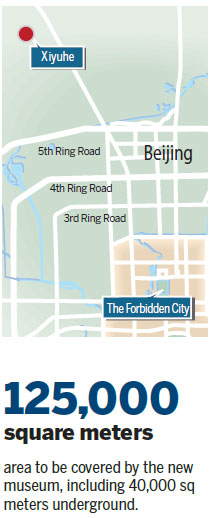

When work starts on the new northern area for Beijing's Palace Museum, also known as the Forbidden City, "maverick architecture" will not be allowed.
This was made clear on Thursday when the design blueprints from five candidates were unveiled.
The new museum, affiliated with the Forbidden City, will cover about 125,000 square meters - including 40,000 sq meters underground - along a river and reservoir in Shangzhuang in northwest Beijing. The location, Xiyuhe, is about 30 km from the Palace Museum.
The entire project, including auxiliary infrastructure and a public park, will occupy as much as 620,000 sq meters.
"The design of a museum is not a fashion that can be easily abandoned when a trend ends," said Shan Jixiang, director of the Palace Museum and a veteran architect. "Once built, it has to serve the public for a long time and live up to the test of history."
In recent years, China has seen a surge in architecture featuring exotic facades, attracting widespread comment that it has become a testing ground for foreign designers.

Shan said international bids were not sought for the new museum's construction because "such a trend will make every Chinese city look similar. Chinese architects deserve this precious chance to prove their talents."
The blueprints have been submitted by architects from institutions including the Chinese Academy of Engineering, Tsinghua University and the Beijing Institute of Architectural Design. Work is planned to start by the end of this year.
The Palace Museum is setting up a panel of nine experts to judge the submissions, and public views will also be heard. The blueprints are on display in the museum for opinions, and the museum's social network account is also open for suggestions.
Some of the blueprints feature the Forbidden City's symmetrical layout, including that of Zhang Yu from the Beijing Institute of Architectural Design.
Zhuang Weimin from Tsinghua University is the only candidate to break away from such a layout - using a long transparent corridor to connect separate halls.
"It's not necessary today to make a replica of the Forbidden City," Zhuang said. "We want to mix Chinese and Western styles and better echo the surrounding natural environment."
The new area will greatly expand exhibition space for the Palace Museum. As China's royal palace from 1420 to 1911, it houses 1.8 million cultural treasures, most of which cannot be shown due to safety concerns.
"For example, it's impossible to exhibit large pieces such as tapestries and furniture in the old museum," said museum director Shan.
The new northern area is expected to attract more than 3 million visitors annually.
wangkaihao@chinadaily.com.cn